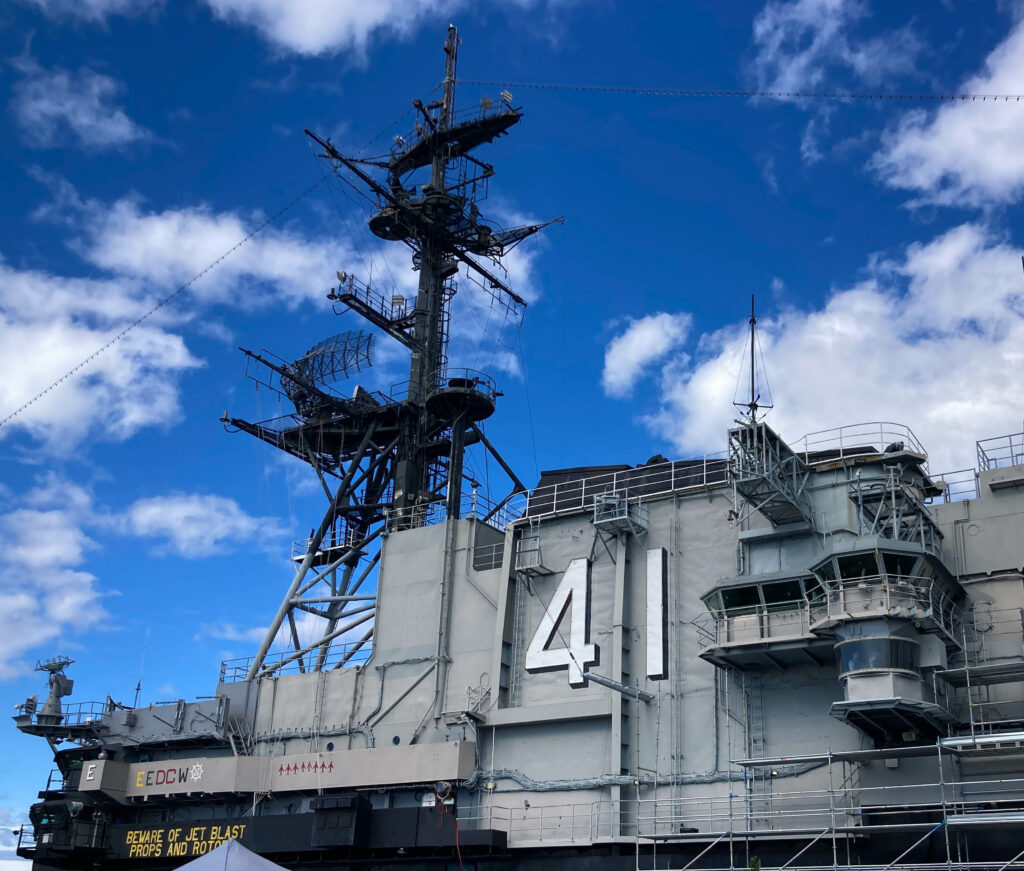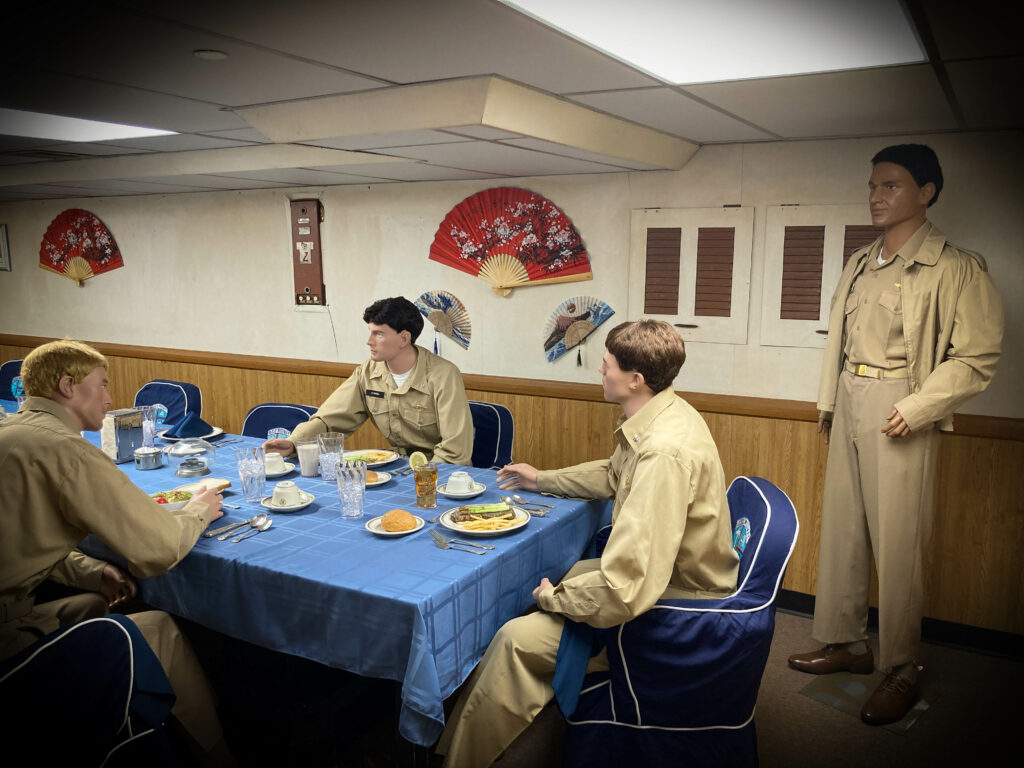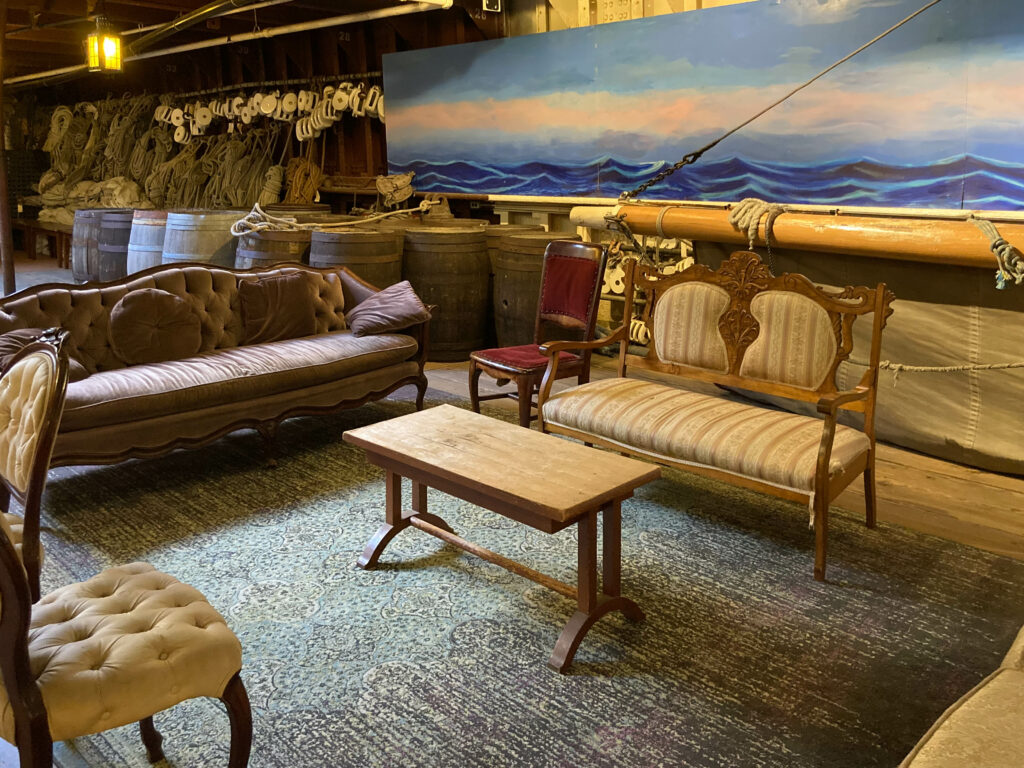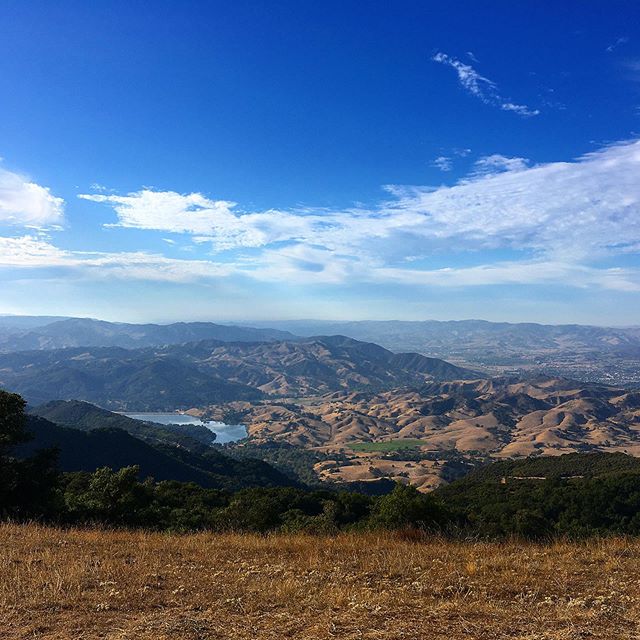A Day along San Diego Bay

Boats dotted the water sparkling in the southern California sun. The light blue sky and the dark blue waters met at the horizon opposite the city skyline. The weather was typical for San Diego — spectacular.
This post contains affiliate links. For more information, click here.
San Diego Bay is a fabulous place for maritime-history buffs. I spent my last day there before boarding a cruise to Mexico exploring the U.S.S. Midway Museum and the Maritime Museum of San Diego.
U.S.S. Midway Museum

The U.S.S. Midway was a 20th-century aircraft carrier.
Midway History
Six months after the Japanese attack on Pearl Harbor pulled the United States into World War II, the two nations fought a naval battle at Midway, an atoll about 1,000 miles from Hawaii in the North Pacific.
The Battle of Midway was a rout, and one of the most far-reaching naval engagements since Actium. The U.S. Navy sank a whopping four Japanese aircraft carriers — which had all participated in the attack on Pearl Harbor. We also sank their heavy cruiser Mikuma.
Japan hid the defeat from its people and went on to build six new aircraft carriers over the next three years. But it never recovered.
On August 8, 1945, the United States dropped an atomic bomb on Hiroshima. Two days later, the Soviet Union declared war on Japan. The next day, we bombed Nagasaki. Less than one month after that, on September 2, Japan surrenderred aboard the U.S.S. Missouri. World War II was over.
In the three years following the Battle of Midway, the United States would build 17 aircraft carriers.
The largest would be named Midway, after the extraordinary battle. But she never served during World War II, as she was commissioned in Norfolk, Virginia, on September 10, 1945, eight days after the Japanese surrender. At the time, she was the largest warship in the world, and the first U.S. carrier too big to pass through the Panama Canal.
As its reward for helping defeat Japan, as well as Germany, the Soviet Union was given control of a large swath of Europe and Asia, which became known as the East Bloc. But by 1947, the Soviets’ expansionist nature gravely concerned President Harry S Truman, who pledged U.S. support for democracies threatened by totalitarian take-overs. This became known as the Truman Doctrine. It marked the beginning of the Cold War, the decades-long tension between the United States and the Soviet Union, dotted with proxy hot wars in Korea, Vietnam, and elsewhere. America and our allies won the Cold War in 1991, thanks mainly to the vision and leadership of President Ronald Reagan, with significant support from U.K. Prime Minister Margaret Thatcher and Pope John Paul II.
The Midway operated throughout the Cold War. Her pilots shot down the first and last MiGs of the Vietnam war, and she led the evacuation of Saigon. She also served as flagship of Persian Gulf air operations during Operation Desert Storm.
The U.S.S. Midway was decommissioned in San Diego on April 11, 1992, after 47 years of service.
Things to See aboard the Midway
Today the U.S.S. Midway is a fascinating museum floating in San Diego Bay. The tour is self-guided. There is an informative audio guide included with your admission ticket; you may use your own earbuds if you wish.
The museum can be divided into three sections:
Hangar Deck

You enter on the Hangar Deck, which not surprisingly houses several aircraft. It also has a short video about the Battle of Midway. There are also flight simulators you can play. The Café 41 restaurant and Jet Express to-go serve lunch items like salads and sandwiches. You can purchase souvenirs at the Jet Shop.
Below Deck

Below Deck was the most interesting part of the museum to me. This is where you learn about daily life aboard the enormous carrier. You’ll see the sleeping quarters, the chow line, the galley, the barber shop, the laundry, the sick bay, and the brig (jail). It’s a fascinating look at how quotidian needs are met at sea. There are lots of docents to answer your questions.
Flight Deck
The Flight Deck is open-air and offers spectacular views of the water and the San Diego skyline. It holds lots of aircraft, and you can climb aboard some of them.
Maritime Museum of San Diego
The Maritime Museum maintains nine historic vessels floating in San Diego Bay. A regular admission ticket gives you access to seven of them for a self-guided tour:
Berkeley
The first vessel you step aboard is the 1898 steam ferry Berkeley. She was the first steel-hulled, double-ended, propeller-driven ferryboat to operate in San Francisco Bay. She helped evacuate the city after the 1906 earthquake, transporting refugees across the Bay to Oakland.
She’s the largest vessel at the Museum. She houses several exhibits, including a Model Gallery. You can also poke around her engine room. The passenger area brings the Victorian Era back to life with its elegant wooden benches and tables.
The Maritime Museum acquired her in 1973.
U.S.S. Dolphin
You step down a ladder into the 1968 submarine Dolphin. She holds several records, including operating depth and torpedo-launch depth. She’s tiny and cramped, so I didn’t linger long, but she provides a rare glimpse at submarine life and operations. The Maritime Museum acquired her in 2008.
Medea
Next is the 1904 steam-powered yacht Medea. A yacht is a large pleasure vessel with at least one sleeping cabin.
The Medea has a fascinating history. She was built for William Macalister Hall, who also owned Torrisdale Castle in Scotland. During World War I, the French Navy purchased her and converted her to a gunboat and used her as a convoy escort protecting French sailing ships.
During World War II, Britain’s Royal Navy used her as a barrage-balloon vessel at the mouth of the River Thames in London. A barrage balloon was a hydrogen-filled device that pulled up steel cables as it rose into the air. The cables protected an area from air attacks, such as by dive bombers and cruise missiles. The British used nearly 3,000 barrage balloons during World War II.
Later in the War, she served as an accommodation ship housing Norwegian Navy commando officers off Scotland. After the War, she became a pleasure vessel again. She was donated to the Museum in the early 1970s.
She’s a beautiful steel vessel furnished with teak and oak and laden with elegant comforts.

San Salvador

Next you’ll come to a replica of the San Salvador, a 1542 galleon. A galleon was a large, multi-decked sailing vessel used primarily by Spain during the 16th to 18th centuries. As a typical galleon, the San Salvador has three masts. Her fore- and main-masts are square-rigged. The mizzen-mast is lateen-rigged.
The San Salvador was the flagship of Juan Rodriguez Cabrillo, the first European to lead an expedition exploring the coast of the area now called California. His party of more than 170 people set sail from the port of Navidad, near modern-day Manzanillo, Mexico, on June 27, 1542, with three vessels. On September 28, they sailed into San Diego Bay, which Cabrillo called “a closed and very good port”. He claimed the surrounding land for Spain. The expedition continued northward, but soon sought refuge from winter weather in the Channel Islands off the coast of Los Angeles. Cabrillo was mortally wounded in a skirmish there with a native tribe and died on January 3, 1543.
The replica was built in 2015, based on research in the fields of maritime archaeology and Iberian maritime history. She was my favorite of all the vessels at the Museum. She offers a rare feel for life at sea during the Age of Exploration. The Museum also offers sailing trips aboard the San Salvador.
Californian
Next is the Californian, a replica of an 1847 revenue cutter, the C.W. Lawrence. During the Gold Rush, revenue cutters patrolled the coastline, looking for smugglers and tax and duty evaders and responding to disasters at sea.
The Californian is a topsail schooner. A schooner is a sailing vessel with two or more masts which are rigged fore-and-aft. A topsail schooner has a square topsail on the fore-mast. Like the Californian, she may also have a topgallant sail above the topsail.
The Californian was built in 1984. The Museum also provides sailing trips on the schooner.
H.M.S. Surprise

Next is H.M.S. Surprise, a replica of the 18th-century British Royal Navy sixth-rate ship Rose. During the Age of Sail, the term ship meant something more precise than it does in modern usage. A full-rigged ship was a sailing vessel with three or more square-rigged masts. During the 17th century, the Royal Navy devised a rating system to classify its ships by size and number of cannon, referred to as guns. Ships were rated first- to sixth-. Fifth- and sixth-rate ships were primarily frigates. A frigate was a fast warship with one gun deck and at least 20 cannon.
The replica was built in 1970. 20th-Century Fox purchased and modified the ship and rechristened her as the H.M.S. Surprise for the excellent 2003 film Master and Commander: the Far Side of the World, based on the novels of Patrick O’Brian. The Maritime Museum acquired her in 2004.
Star of India
The last vessel to board is the Star of India. She began life in 1863 as the full-rigged ship Euterpe. In 1901, she was rigged down to a barque, meaning she now carried fore-and-aft sails on her mizzen-mast. This sail plan requires less manpower than full rigging.
She has a rich history of making trade voyages to India and later carrying emigrants from England, Ireland, and Scotland to New Zealand. Over the years, she faced threats on the seas ranging from cyclone to a mutiny.
The Maritime Museum acquired her in the 1960s. There is lots to explore aboard the barque about her history and the Age of Sail.

The Maritime Museum also has two boats that are not part of the regular tour but are available for cruises in the Bay:
Pilot Boat
A maritime pilot guides a vessel in or out of an especially tight or tricky waterway, like a harbor or a river mouth. The pilot boards the vessel and helps the crew navigate through the waterway. He does not take command of the vessel, except at the Panama Canal. The boat that the pilot arrives and departs on is called a pilot boat.
The 1914 Pilot boat was donated to the Maritime Museum in 1996. She’s the oldest wooden pilot boat in the country. She still occasionally ferries harbor pilots to and from historic vessels entering or leaving San Diego Bay.
PCF 816 Swift Boat
The U.S. Navy used Patrol Craft Fast vessels during the Vietnam War. These so-called Swift Boats conducted operations ranging from blocking supplies on their way to the communist Viet Cong to transporting SEAL teams. The Maritime Museum acquired PCF 816 in 2011. She is considered the last fully intact vessel of her type.
All in all, it was a wonderful day spent floating from era to fascinating era of maritime history.
* * *
Continue your adventure in the Southwest:

After my misspent youth as a wage worker, I’m having so much more fun as a blogger, helping other discerning travellers plan fun and fascinating journeys. Read more …







